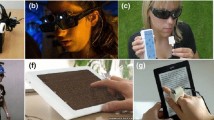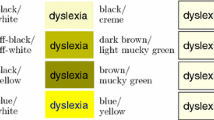Abstract
Much has been written concerning the difficulties faced by visually handicapped persons when they access the internet. To solve some of the problems and to make web pages more accessible, we developed a tool we call the “Easy Bar,” which works as a toolbar on the web browser. The functions of the Easy Bar are to change the size of web texts and images, to adjust the color, and to clear cached data that is automatically saved by the web browser. These functions are executed with ease by clicking buttons and operating a pull-down list. Since the icons built into Easy Bar are quite large, it is not necessary for the user to deal with delicate operations. The functions of Easy Bar run on any web page without increasing the processing time. For the visually handicapped, Easy Bar would contribute greatly to improved web accessibility to medical information.
Similar content being viewed by others
References
Ministry of Internal Affairs and Communications, Information and Communications in Japan. White Paper, Chap. 1:12–38, 2004.
Institute for Information and Communications Policy, “Shogai no aru katagata no Internet toh no riyo ni kansuru tyosa hokokusyo-kokumin zenpan no joho kankyo tono hikaku wo tsujite” (in English, Survey Report on the Actual Situation of the Use of Internet for the Handicapped Person). http://www.soumu.go.jp/iicp/seika/data/research/survey/telecom/2003/0306-all.pdf, Chap. 2:52–99, 2003 (in Japanese).
Ministry of Internal Affairs and Communications, Communications Usage Trend Survey. http://www.soumu.go.jp/s-news/2004/pdf/040414_1_a.pdf, 2004.
World Wide Web Consortium (W3C), Web Content Accessibility Guideline 2.0. http://www.w3.org/TR/WCAG20/.
Edward, W. F., and Michael, A. S., Timing attacks on Web privacy. Proceedints of the 7th ACM Conferrence on Computer and Communications Security, 25–32, 2000.
Takagi, H., Asakawa, C., Fukuda, K., and Maeda, J., Site-wide Annotaion: Reconstructing Existing Pages to be Accessible. Proceedings of The Fifth International ACM Conference on Assistive Technologies (ASSETS 2002), 81–88, 2002.
Takagi, H., and Asakawa, C., Transcoding Proxy for Nonvisual Web Access. Proceedings of The Fifth International ACM Conferrence on Assistive Technologies (ASSETS 2000), pp. 164–171, 2000.
Kottapally, K., Ngo, C., Reddy, R., Pontelli, E., Son, T. C., and Gillan, D., Towards the Creation of Accessibility Agents for Non-visual Navigation of the Web. Proceedings of The 2003 Conference on Universal Usability, pp. 134–141, 2002.
Pavel Zolnikov, Extending Explorer with Band Objects using.NET and Windows Forms. http://www.codeproject.com/csharp/dotnetbandobjects.asp, 2002.
Microsoft, MSHTML Reference. http://msdn.microsoft.com/library/default.asp?url=/workshop/browser/mshtml/reference/reference.asp.
World Wide Web Consortium (W3C), Document Object Model (DOM). http://www.w3.org/DOM/.
Tibbitts, B. R., Crayne, S., Hanson, V., Brezin, J., Swart, C., and Richards, J. T., HTML Parsing in Java for Accessibility Transformations. XML 2002 Proc., 2002.
The Accessibility Information Solutions (AIS) at the National Information and Library Service (NILS), Web Accessibility Toolbar. http://www.nils.org.au/ais/web/resources/toolbar/.
Miller, R. B., Response time in man-computer conversational transactions. Proc. AFIPS Fall Joint Computer Conf. 33:267–277, 1968.
Card, S. K., Robertson, G. G., and Mackinlay, J. D., The information visualizer: An information workspace. Proc. ACM CHI'91 Conf. 181–188, 1991.
Author information
Authors and Affiliations
Corresponding author
Rights and permissions
About this article
Cite this article
Fujiki, T., Hanada, E., Yamada, T. et al. A Tool for Improving the Web Accessibility of Visually Handicapped Persons. J Med Syst 30, 83–89 (2006). https://doi.org/10.1007/s10916-005-8373-5
Received:
Accepted:
Issue Date:
DOI: https://doi.org/10.1007/s10916-005-8373-5




